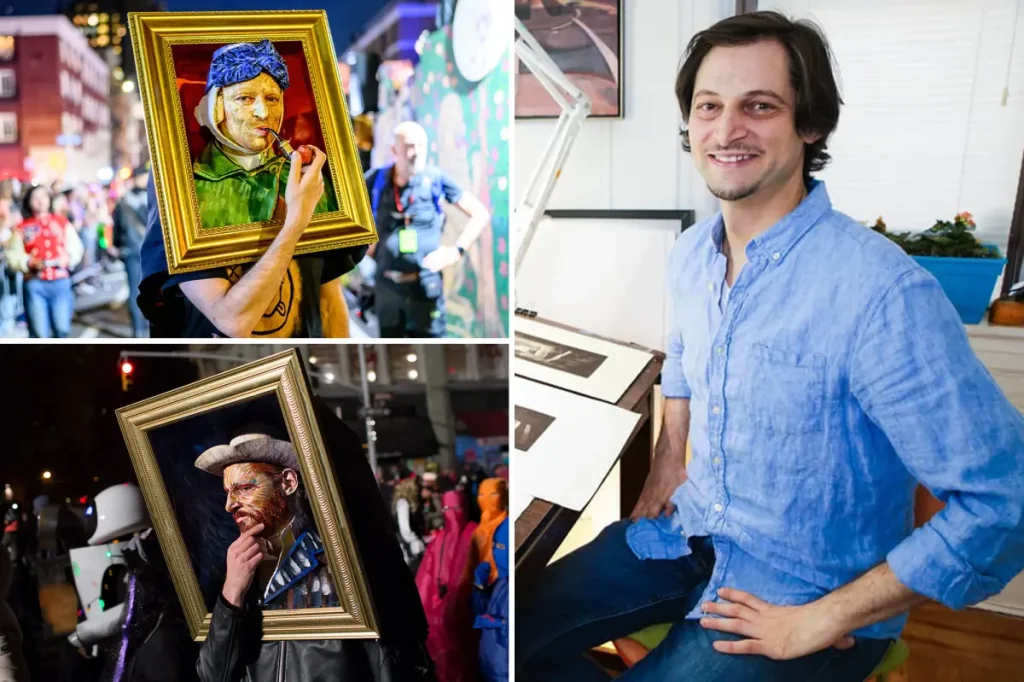The Passionate Pursuit of Art: One Man’s Van Gogh Halloween Tradition
For the past 15 years, James Haggerty has transformed Halloween night in New York City into his own living art exhibition. The 52-year-old art teacher has become something of a legend at the Village Halloween Parade, where he meticulously embodies different interpretations of Vincent van Gogh’s self-portraits. His dedication to capturing the essence of the troubled Dutch master goes far beyond a simple costume – it’s a moving artwork that captivates thousands of parade-goers each year. “During one night, I could take hundreds of photos,” Haggerty told The Post, referring to the countless admirers who stop him for a picture with his remarkable creation. In a city known for its creative Halloween expressions, Haggerty has managed to stand out by turning himself into a walking masterpiece that honors one of history’s most beloved and tormented artists.
The preparation for Haggerty’s annual transformation begins two months before Halloween, a testament to his commitment to authenticity and artistry. “A frame is in the foreground, there’s a background, and I’m sort of in the middle,” he explained, describing his ingenious costume design that quite literally frames him as a walking canvas moving down Sixth Avenue. What makes Haggerty’s portrayal particularly impressive is his obsessive attention to detail. “Over the years, the level of authenticity has increased, where I spend a lot of time paying attention to the period clothing, the brushwork. And I really try to get that natural emotion that Van Gogh has in all of his works,” he said. This isn’t simply a man in costume – it’s an artist paying homage to another artist through a living, breathing interpretation that merges performance art with historical appreciation.
On the day of the parade, Haggerty dedicates three to four hours solely to applying his facial makeup, carefully recreating the distinctive features of van Gogh, including the infamous ear that the Dutch painter famously mutilated. The emotional intensity that characterized van Gogh’s brief but prolific life – he died by suicide at just 37 years old – is something Haggerty strives to capture in his portrayal. “I think his energy and emotion and style lends itself very well to Halloween,” Haggerty noted, highlighting the connection between the holiday’s embrace of the macabre and the painter’s tumultuous life story. Indeed, there’s something hauntingly appropriate about channeling van Gogh’s spirit on a night dedicated to blurring the boundaries between worlds, much as the painter’s work blurred the line between reality and emotional expression.
Such dedication doesn’t come without challenges. Haggerty’s artistic perfectionism means he sometimes struggles to complete his primary costume concept in time for the parade. “There have been numerous years where I was working on one costume, wasn’t able to finish it, but also had a backup plan for one that would take less time,” he confessed. This level of preparation demonstrates not just artistic vision but practical foresight – qualities that both Haggerty and van Gogh share across centuries. For this year’s parade, which expects 80,000 participants and more than 2 million spectators, weather forecasts predict high winds – a potential catastrophe for many elaborate costumes. Yet Haggerty remains unfazed: “I’m inside of a frame, so it keeps me dry,” he explained with the confidence of someone who has thought through every detail of his creation.
What makes Haggerty’s annual tribute particularly meaningful is the way it connects art history with contemporary celebration. As an art teacher by profession, Haggerty’s Halloween transformation serves as both personal expression and public education. While many parade-goers might recognize van Gogh’s iconic self-portrait, Haggerty’s living interpretation brings new dimensions to the work. His costume invites observers to consider the brushwork, color choices, and emotional context of van Gogh’s art in ways that static museum experiences might not. In a city filled with artistic expression, Haggerty has carved out a unique niche that bridges high art and popular culture, making van Gogh’s genius accessible to audiences who might otherwise never step into an art gallery.
Beyond the spectacle and creativity, Haggerty’s fifteen-year commitment to this character reveals something deeply human about our relationship with art and artists. Van Gogh, who sold just one painting during his lifetime and struggled with mental illness throughout his short career, has become one of history’s most celebrated artists posthumously. Haggerty’s annual homage seems to acknowledge this bittersweet recognition – celebrating the artist who never lived to see his own success. As Haggerty walks the parade route year after year, he carries forward not just the image but the spirit of van Gogh, reminding us that great art transcends time, speaks across centuries, and sometimes, on one magical night in New York City, steps right out of its frame and walks among us. In bringing van Gogh to life each Halloween, Haggerty reminds us why we continue to be moved by art long after its creators have departed – because in those brushstrokes, we recognize something eternally and universally human.


